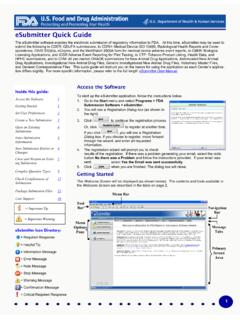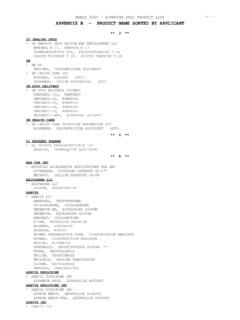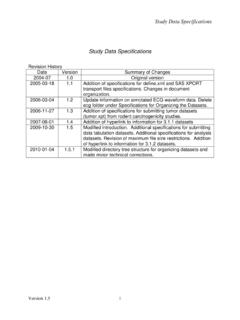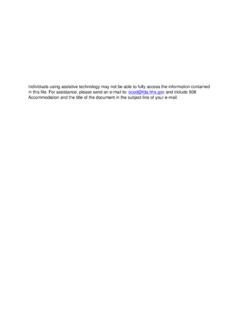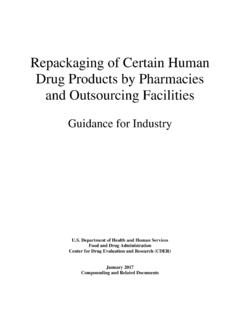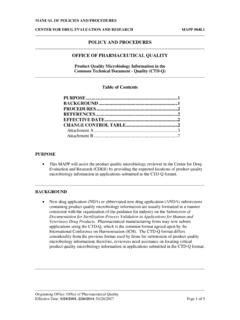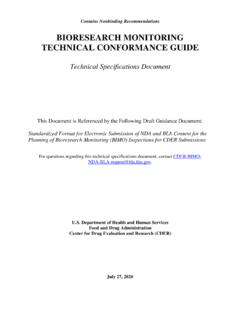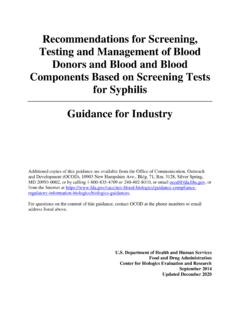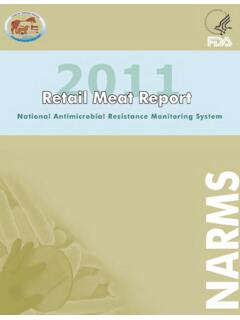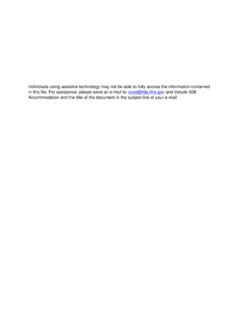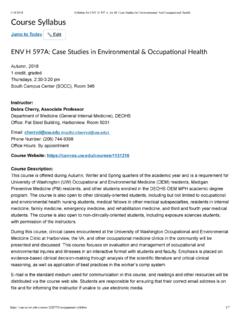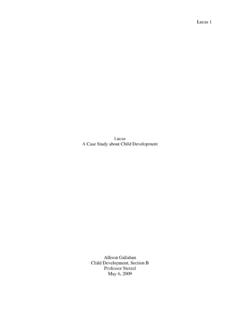Transcription of CGMP Case Studies - Food and Drug Administration
1 Quality Production Laboratory Materials Facilities and Equipment Packaging and Labeling Regulatory Education for Industry (REdI): Focus on CGMPs & FDA Inspections Sheraton | Silver Spring, MD | July 15-16, 2015 CGMP case Studies Tamara Felton Clark Branch Chief (acting) Office of Manufacturing Quality, Division of drug Quality II, Global Compliance Branch 4 Quality Production Laboratory Materials Facilities and Equipment Packaging and Labeling The Six Components Quality Production Laboratory Materials Facilities & Equipment Packaging & Labeling Quality Production Laboratory Materials Facilities and Equipment Packaging and Labeling These cases lead to: FDA Form 483 observations Warning Letters Recalls Import Alerts Regulatory meetings Quality Production Laboratory Materials Facilities and Equipment Packaging and Labeling case 1 Facilities & Equipment System Background: Repackaging beta-lactams in a facility that is not dedicated Personnel move freely between beta-lactam and non-beta-lactum manufacturing Quality Production Laboratory Materials Facilities and Equipment Packaging and Labeling case 1: Facilities & Equipment System What Happened: After discussions with FDA, firm recalled the product.
2 Firm ceased manufacturing of beta lactams. Firm decontaminated and renovated facility FDA issued a Warning Letter Quality Production Laboratory Materials Facilities and Equipment Packaging and Labeling case 1: Facilities & Equipment System Takeaways: No safe level of beta lactam contamination. Severe allergenic response can occur when exposed to extremely low levels of beta-lactams. Cleaning cannot substitute for proper segregation. Any test intended to detect beta-lactam contamination provides only limited confidence due to analytical method limitations. Complete segregation is important. Quality Production Laboratory Materials Facilities and Equipment Packaging and Labeling case 2 Packaging & Labeling System Background: Firm repackages therapeutically significant drugs Operators are changing the master labels No written procedures for manual repackaging Complaints of air bubbles and low fill volumes Quality Production Laboratory Materials Facilities and Equipment Packaging and Labeling case 2: Packaging & Labeling System What Happened: Firm recalled FDA issued a Warning Letter citing inadequate manufacturing controls and misbranding violation Quality Production Laboratory Materials Facilities and Equipment Packaging and Labeling case 2: Packaging & Labeling System Takeaways: When a drug product is repackaged, its characteristics may change that could impact the safety and efficacy.
3 Improper repackaging of drug products can cause serious adverse events. A repackager must comply with all applicable sections of 21 CFR Parts 210 and 211. Quality Production Laboratory Materials Facilities and Equipment Packaging and Labeling case 3: Production System Background: Firm markets an extended release tablet. Production included manufacture of extended release beads which were blended with excipients and then compressed. Test for Press Parameters Blending Compression QA Testing Operations had to pre-compress blend samples in the lab to determine operating parameters for the tablet press. Different blends would require different settings, and the firm had no idea why. Quality Production Laboratory Materials Facilities and Equipment Packaging and Labeling case 3: Production System What Happened: During a routine FDA inspection, investigators saw the pre-compression practice.
4 Investigators also found inadequate release testing, especially in light of known process problems. Warning Letter issued for lack of process validation. Quality Production Laboratory Materials Facilities and Equipment Packaging and Labeling case 3: Production System Takeaways: Operational parameters should be selected using risk-based, science-based approach. Process design/qualification (Stage 1-2) must be completed and adequate prior to distribution of your product. Knowledge gained during scale-up should be incorporated into process design/control strategy. Sampling plans for batch release should be scientifically sound. Quality Production Laboratory Materials Facilities and Equipment Packaging and Labeling case 4: Laboratory System Background: Firm manufactures multiple transdermal patch products for many years. Firm developed a new drug , utilizing the same adhesion matrix as it did for others.
5 1st year on the market received ~5000 complaints regarding efficacy and difficulty using the patch. Up to 25% of the drug was sticking to the liner. Quality Production Laboratory Materials Facilities and Equipment Packaging and Labeling case 4: Laboratory System What Happened: Firm s investigation indicated a drug /adhesive interaction problem. Firm argued that since there were no specifications regarding peel force in their application, a recall wasn t warranted, and it could continue to distribute. Firm ultimately recalled. FDA issued a Warning Letter citing lack of specifications, as well as a failure to assure proper strength. Firm established a peel force specification. Quality Production Laboratory Materials Facilities and Equipment Packaging and Labeling case 4: Laboratory System CMC review and the CGMP program: 21 CFR (e) "Written records required by this part shall be maintained so that data therein can be used for evaluating at least annually, the quality standards of each drug product to determine the need for changes in drug product specifications or manufacturing or control procedures.
6 Written procedures shall be established and followed for such Important to use product experience to improve your product and process in a timely manner. Quality Production Laboratory Materials Facilities and Equipment Packaging and Labeling case 4: Laboratory System Takeaways: Don t assume what worked before will work under different conditions. Evaluate data to determine the need for changes in drug product specifications. Quality Production Laboratory Materials Facilities and Equipment Packaging and Labeling case 5: Materials System Background: Firm makes an injectible drug . Multiple adverse events and complaints which indicated presence of endotoxin FDA inspected the firm. Firm had not identified a root cause. Firm started to test for endotoxin in-process, prior to terminal sterilization, for information only. Firm had found in-process results that were OOS, but finished product tested in specification.
7 Quality Production Laboratory Materials Facilities and Equipment Packaging and Labeling case 5: Materials System What Happened: FDA questioned the firm on the high in-process results. As a response to the investigators, the firm ceased in-process testing for endotoxin. Quality Production Laboratory Materials Facilities and Equipment Packaging and Labeling case 5: Materials System What Happened Next: FDA issued a Warning Letter. After discussions with FDA, firm recalled the product. As a corrective action, the firm worked with the agency to develop a work plan to find the source of the endotoxin. Eventually the firm determined that the endotoxin came from a raw material, and that the toxin was able to make it through the manufacturing process. Quality Production Laboratory Materials Facilities and Equipment Packaging and Labeling case 5: Materials System Takeaways: Quality cannot be tested into products; it should be built-in or should be by design Raw materials (including excipients), container closure systems, and manufacturing processes that are critical to product quality should be determined and control strategies justified.
8 Quality Production Laboratory Materials Facilities and Equipment Packaging and Labeling 21 case 6: Materials System Background: Firm makes a tablet product containing a dissolution aid. Supplier announces it will be discontinuing dissolution aid. Firm analyzes other sources and finds a like for like substitute. Firm initiates plant trial to evaluate material change. Testing for trial batches will require some time. Firm decides to manufacture multiple lots for market with new dissolution aid without having complete data from the trial batches. Quality Production Laboratory Materials Facilities and Equipment Packaging and Labeling case 6: Materials System What Happened Next: QC testing showed that all product intended for market made with the new aid failed. All product with the new aid intended for market had to be destroyed, costing the firm millions of dollars. Firm bought all of the original dissolution aid on the market and now has a year s worth in stock.
9 Firm is still working to find a solution. Quality Production Laboratory Materials Facilities and Equipment Packaging and Labeling case 6: Materials System Takeaways: Do not manufacture at risk. Two materials meeting the same compendial specifications are not necessarily equivalent for use in manufacturing your product. Limit exposure to supply chain risks by qualifying multiple sources of raw materials. Knowing and understanding your supply chain can prevent problems. Quality Production Laboratory Materials Facilities and Equipment Packaging and Labeling case 6: Materials System Takeaways: Quality Production Laboratory Materials Facilities and Equipment Packaging and Labeling case 7: Production System Background: Firm manufactures a chewable tablet. Routine stability testing found some tablets had 3 times the target of API. Release testing had not detected the problem.
10 Quality Production Laboratory Materials Facilities and Equipment Packaging and Labeling case 7: Production system What Happened: Firm immediately recalled all product. Firm determined that different particle sizes, densities, and flow properties caused the blend to desegregate during blender discharge. Firm worked to correct problem by reducing free fall . Firm also implemented these corrections to other products with the same problem. Quality Production Laboratory Materials Facilities and Equipment Packaging and Labeling case 7: Production System Takeaways: For pre-compression blending, firm should evaluate uniformity of the material entering the press. Investigation should be extended to other batches, other products, and other points in the process. Release testing may not be a reliable method for catching process problems. Quality Production Laboratory Materials Facilities and Equipment Packaging and Labeling case 8: Quality System Contractors are being used frequently in the pharmaceutical industry.
